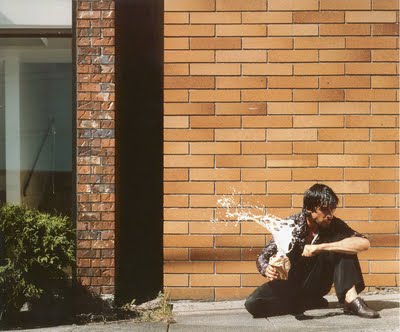Jeff Wall
Sunday, 9 August 2009
“There have been times (and particular pictures) in the past when it seemed that Jeff Wall was determined to take the technical image from classicism to mannerism in one digital swoop. But in his recent works, the style (or stylelessness) of the pictures definitely acts as a vehicle for meaning.
Even though the six images displayed in the front gallery (three large black-and-white photographs and three color light boxes) were not made as a series, the correspondences among them lead inexorably to linked narratives. Four images depict social scenes in the “near-documentary” mode, wherein the apparently instantaneous is laboriously limned. In Forest, 2001, a woman strides away from a rough campsite in a wooded ravine. In Dawn, 2001, a graffiti-covered stone, power pole, and Dumpster occupy a dead-end commercial zone, a waste place protected by a chain-link fence topped with barbed wire. We see the backs of four hurrying travelers in Overpass, 2001, schlepping their bags over a bridge as a storm gathers in the distance. And in Night, 2001, a woman sits against a concrete abutment, her meager possessions strewn along the edge of a dark pool.
All four images depict events and conditions that occur daily around the edges of Capital: peripheral transitions highlighting the ultimate precariousness of possessions. Two images show women without shelter, another shows people in harried transit, and the tagged stone and Dumpster mark the contested boundary between private ownership and public expression. Two other pictures in this gallery (Logs, 2002, and Cuttings, 2001) show nature (trees) transformed into product (building material and fuel) and act as transitional still lifes among the larger narrative pictures; they also remind us of the utter artificiality of these documentary-style images.
How do images so extravagantly made (not taken) still draw on photography’s special relation to the real? Because the individual elements in Wall’s images register as photographic, our photographically derived belief in them carries over to the whole. This synecdochic leap across the mechanical/digital divide (from photograph to pictograph) gives these synthetic pictures a residual believability that Wall exploits to great effect.
In the second gallery was After Invisible Man by Ralph Ellison, the Preface, 1999-2001, fresh from its debut at Documenra 11, where it was one of the most effective interventions in the documentary-aesthetic dialogue that defined that exhibition. It shows Ellison’s narrator in his Harlem basement, where he has festooned the ceiling with 1,369 incandescent lightbulbs in order to make the dank hole brighter than “the Empire State Building on a photographer’s dream night.” The Invisible Man sits under this canopy of light, on the edge of a folding chair, listening, we imagine, to Louis Armstrong on the phonograph singing “What Did I Do to Be So Black and Blue.”
It is a powerful composition, full of telling detail. At its center is an altar of sorts, with a small bust (of Beethoven?), a lucky horseshoe, a crucifix, cowboy hat, bull’s horn, and blackface ceramic mask. To the left hangs a yellow rabbit’s foot, and on the wall to the right is pinned an American flag, a torn picture of Christ as Shepherd, and a few illegible old photographs. Paired here with Rainfilled Suitcase, 2001, an image that seems to depict the aftermath of a catastrophe involving fire and water, Wall’s Invisible Man becomes a kind of threnody, perhaps even a prescient threnody for post-September 11 New York” – Art Forum International Magazine



